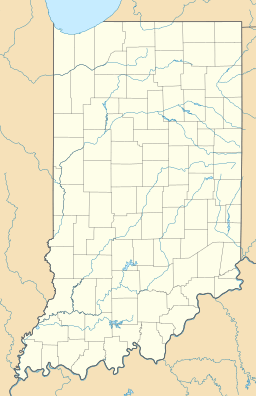Gibson Lake (Indiana) facts for kids
Quick facts for kids Gibson Lake |
|
|---|---|
| Location | Gibson Generating Station, Montgomery Township, Indiana |
| Coordinates | 38°21′N 87°46′W / 38.35°N 87.76°W |
| Type | reservoir (cooling pond) |
| Primary inflows | Lake Fill Pumps, Plant Water Discharges, Mc Carthy Ditch |
| Primary outflows | Patoka River, Plant Water Intakes |
| Basin countries | United States |
| Max. length | 1.5 mi (2.4 km) |
| Max. width | 2 mi (3.2 km) |
| Surface area | 2,900 acres (1,200 ha) |
| Average depth | 15 ft (4.6 m) |
| Max. depth | 24 ft (7.3 m) |
| Water volume | 7,100,000,000 US gal (0.027 km3) |
| Residence time | 2 weeks |
| Shore length1 | 6 mi (9.7 km) (includes the central splitter dike) |
| Surface elevation | 350 ft (110 m) |
| Frozen | never |
| Islands | none |
| Settlements | Mount Carmel, Illinois (2 miles NW of the lake) |
| 1 Shore length is not a well-defined measure. | |
Gibson Lake is a very large pond in Indiana, USA. It was built to help cool down the Gibson Generating Station, a big power plant run by Duke Energy. This special lake is called a cooling pond.
At about 3,500 acres (14 km2), Gibson Lake is the biggest lake in Indiana that was built completely above the ground. Its edges are made of strong rock walls called levees.
For many years, starting in 1978, Gibson Lake was a popular spot for fishing. People could catch bass, catfish, bluegill, and carp there. However, fishing was stopped in 2007. This happened because a natural element called selenium was found in the water. This made it unsafe for fish to be eaten.
The only way to get to Gibson Lake is through its boat ramp. You can find it southeast of the power plant on Gibson County Road 975 South.
Because of the warm water coming from the power plant, Gibson Lake almost never gets colder than 40 °F (4 °C). This warm water can sometimes cause a light dusting of snow in the areas nearby!
Contents
Amazing Animals at Gibson Lake
The area around Gibson Lake and the Gibson Generating Station is a home or a stopping point for many different kinds of birds. Bird watchers love to visit this spot!
Many of these birds use the lake area as a place to rest and refuel during their long journeys. If you look at Google Earth or Garmin GPS maps, you might see the lake's location called "Broad Pond." This area was once thought of as a possible National Wildlife Refuge.
Special Birds to Spot
- Least terns: These birds nest at Gibson Lake and a nearby area called Cane Ridge. You can often see them from mid-May until late August or early September.
- Bald eagles: These majestic birds are common during the winter months. You can usually spot them if you drive around the lake's levee. They build their nests near the Wabash River.
Why is Gibson Lake So Warm?
The water in Gibson Lake rarely drops below 40 °F (4 °C). This is mainly because the power plant releases warm water into the lake. This warm water often causes a special kind of snow or heavy frost in nearby areas, known as lake-effect snow.
Warm Water Near the Plant (West Side)
This part of the lake is closest to where the warm water leaves the power plant.
| Season | Min | Max |
|---|---|---|
| Winter | 50 °F (10 °C) | 65 °F (18 °C) |
| Summer | 95 °F (35 °C) | 110 °F (43 °C) |
Cooler Water (East Side)
This side of the lake is where the water is a bit cooler.
| Season | Min | Max |
|---|---|---|
| Winter | 40 °F (4 °C) | 55 °F (13 °C) |
| Summer | 88 °F (31 °C) | 95 °F (35 °C) |
A long wall, called a splitter dike, sticks out about 500 yards into the lake from the power plant. This dike makes the water stay in the lake for about one to two weeks before it flows out. This helps the water cool down properly for the power plant.



